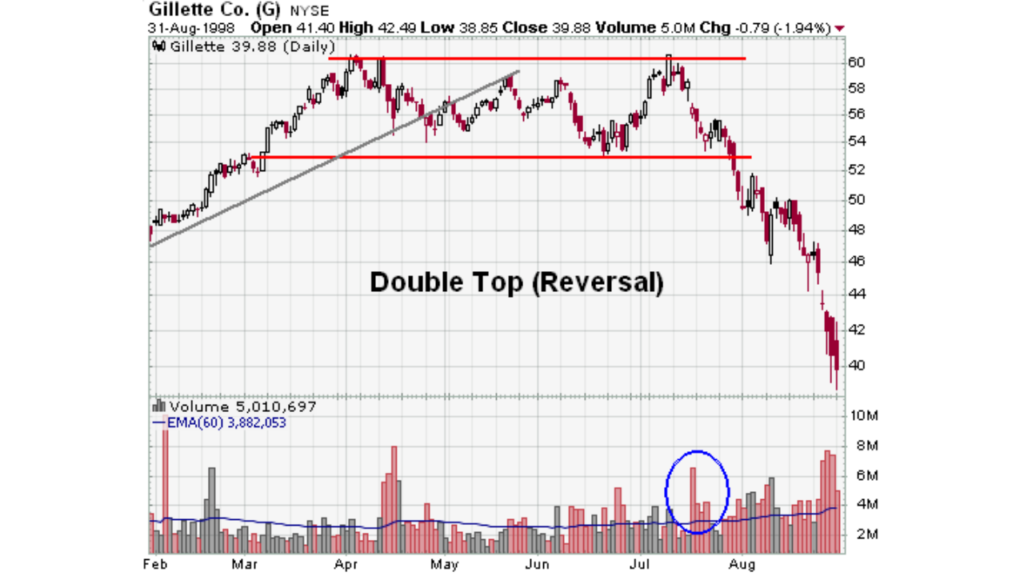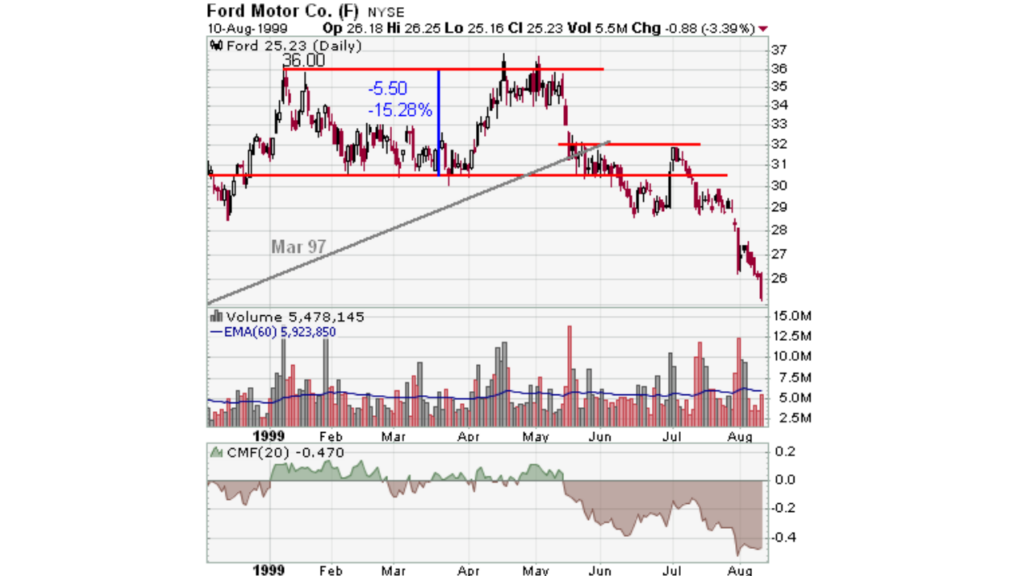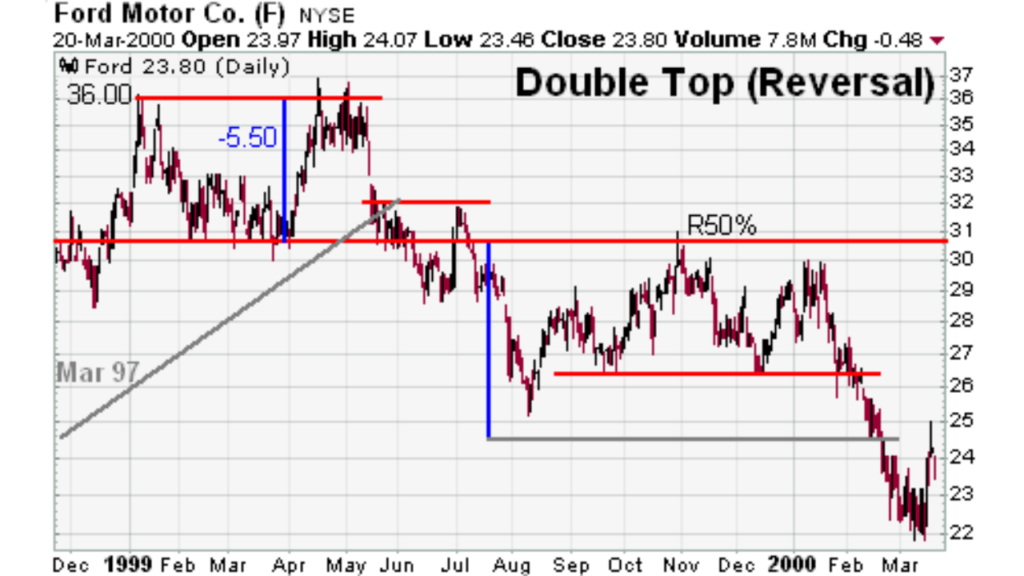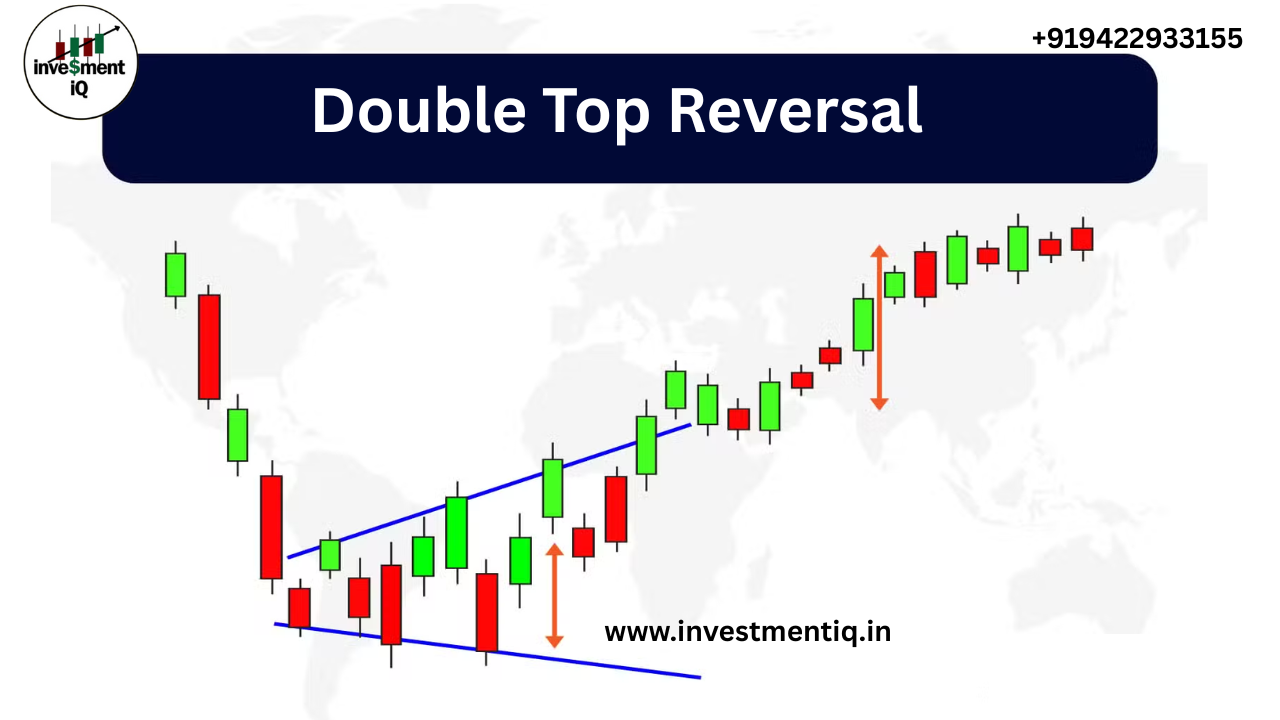Explore the Double Top Reversal chart pattern and learn to identify, interpret, and trade this common bearish reversal pattern.
A common bearish reversal pattern on bar, line, and candlestick charts is the Double Top Reversal.As the name suggests, the pattern consists of two about equal peaks that are followed by a mild dip.
The traditional Double Top Reversal pattern indicates at least an intermediate-term shift from bullish to bearish, though there may be variances. An illustration of a Double Top Reversal can be seen in the chart below.

Example of a classic Double Top Reversal pattern.
Note: A Double Top Breakout on a P&F chart is not the same as a Double Top Reversal on a bar or line chart. Bullish patterns that indicate an upside-resistance breakout are double breakouts on P&F charts.
Along the way up, a lot of possible Double Top Reversals can emerge, but a reversal cannot be verified until important support is broken.
The following are key points in the Double Top formation:
- Prior Trend. With any reversal pattern, there must be an existing trend to reverse. In the case of the Double Top Reversal, a significant uptrend of several months should be in place.
- First Peak. The first peak should mark the highest point of the current trend. As such, the first peak is fairly normal, and the uptrend is not in jeopardy (or in question).
- Trough. After the first peak, there is generally a 10-20% decline. Volume on the decline is usually inconsequential. The lows are sometimes rounded or drawn out a bit, which can signify tepid demand.
- Second Peak. The advance from the trough usually occurs with low volume and rises to the previous high. Resistance from the previous high should be expected. Only after meeting resistance will a Double Top Reversal pattern be possible. It still needs to be confirmed. The time between peaks can vary from a few weeks to many months, with the norm being one to three months. While exact peaks are preferable, there is some leeway. Usually, a peak within 3% of the previous high is adequate.
- Decline from Peak. The subsequent decline from the second peak should witness an expansion in volume and/or an accelerated descent, perhaps marked by a gap or two. Such a decline shows that demand forces are weaker than supply, and a support test is imminent.
- Support Break. Even after trading down to support, the Double Top Reversal and trend reversal are still incomplete. Breaking support from the lowest point between the peaks completes the Double Top Reversal. This should occur with increased volume and/or an accelerated descent.
- Support Turned Resistance. Broken support becomes potential resistance; sometimes, this newfound resistance level is tested with a reaction rally. Such a test can offer a second chance to exit a position or initiate a short.
- Price Target. Subtract the distance from support break to peak to obtain a price target. This would infer that the bigger the formation is, the larger the potential decline.
Even though the Double Top Reversal formation may appear straightforward, it is necessary to take the necessary precautions to steer clear of deceptive Double Top Reversals. A month should separate the peak periods
. If the peaks are too close together, it could be normal resistance rather than a long-term shift in the picture of supply and demand. Make sure that the low that lies in between the peaks decreases by at least 10%. It’s possible that declines below 10% do not indicate a significant rise in selling pressure.
Look for a decrease in volume as another sign of weakening demand when the security moves up. Avoiding jumping the gun is perhaps the most crucial aspect of a Double Top Reversal. With an increase in volume, wait until support is broken.
You can tell the difference between true and false support breaks by using a price or time filter. Before being validated, a price filter might require a support break of 3%. The support break might have to hold for three days for a time filter to be considered valid. Until proven otherwise, the trend will continue to exist. This is also true for the Double Top Reversal.
The trend is still upward until a convincing break of support occurs. The double top formation took five months to form, as shown in the chart below. A newfound resistance was put to the test again almost four months after the support break.

An example of a double top formation that took five months to form.
Let’s walk through the above chart.
- Ford’s stock price advanced from a low near 10 in March 1997 to 36 by December 1998. The trend line extending up from March 1997 is an internal trend line, and Ford held above it until the break in May 1999.
- The stock declined around 15% from the first peak to form the trough.
- After reaching a low near 30 1/2 in early February, the trough formed over the next two months. There wasn’t a rally until early April. This long-drawn-out low suggested tepid demand.
- The decline from $36.80 occurred with two gaps down and increased volume. Furthermore, the Chaikin Money Flow moved below -10%. The speed at which money flows deteriorated indicated a significant increase in selling pressure.
- In late May and early June, the stock traded for about three weeks at support from the previous low. During this time, money flows declined below -20%. Even though the situation looked ominous, the double formation would not be complete until support was broken.
- Support was broken in early June when the stock fell below $28.50. That’s more than 3% below support at $30.50. This sharp drop was followed by an equally sharp advance and the stock price was back above the newfound resistance level. A test of broken support can happen, but typically not this early. The advance to $32 in late June may have triggered some short-covering by those who jumped in on the first support break. The stock fell to $25 and then began the retracement advance that would ultimately test support.
According to the chart below, the slide from $36.80 to $25 was 50% retraced at $31, and $30.75 was the support became resistance level. In conjunction with the early June and early July price movement, a resistance zone between $31 and $32 is likely to form. The stock then fell to about $22 by mid-March after reaching a lower high of $30 in January 2000.


you may be interested in this blog here:




